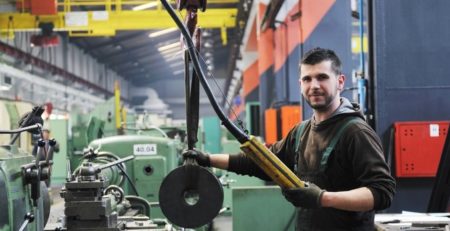8 ways not to waste resources.
8 ways not to waste resources.
Are cost reductions, shortened production times and better quality aggregates possible without costly investments? The Japanese concept of Lean Manufacturing says it is! The most crucial thing is to solve problems at the source and to identify the different kinds of waste – factors that consume our time, people, energy, resources and money.
The philosophy of Lean Manufacturing originated in Japan. It was established decades ago in response to Toyota’s company crisis after the Second World War – in the face of rampant inflation and limited financial resources, Toyota could not afford to continue operating standard mass production lines, which resulted in enormous inventories. Thus, a new work philosophy was developed that has been in use by Toyota until this day – Lean philosophy – thanks to which Toyota has recorded an operating loss only once since 1950. The philosophy is resistant to market turmoil and even natural disasters (such as supply standstills following the disaster at Fukushima nuclear power plant after the 2011 earthquake/tsunami). Lean philosophy has been utilised by numerous companies around the world, not only in the manufacturing industry but also in health care, accounting, services and sports.
The Lean concept philosophy is based on ‘eight types of waste’. Let’s take a look at the processes in your company while searching for answers to the following question: What exactly do my clients pay me for? What do they expect from me?
- They want me to produce defective products requiring re-processing (aggregate requiring re-sifting, crushing, drying, rinsing).
- They want my workers and machines to wait (for extraction of aggregates and their processing, for a loading machine, an excavator, spare parts, fuel, for servicing and breakdown issues).
- They want the product to be overly processed (rinsing aggregate that doesn’t require it, quantity share of more expensive fraction above the level ordered by the client; too-high quality).
- They want me to produce unsolicited goods (too early and too much; according to our own recipes and not the needs of the client; fast producing at the expense of a lower yield of the best fractions; chasing reduced unit costs).
- They want my workers to perform unnecessary work (climbing ladders, searching for tools, covering a distance of many kilometres to reach equipment and devices, reaching for fixings during repair work, having difficulties doing refits, making multiple trips up to the PIT heap to take in aggregate, topping up the car while loading).
- They want me to gather supplies (products waiting for the customer for further processing for days, weeks, months and years; products that must be transported, processed, passed around, improved, counted, etc).
- They want me to transport the product (transport by loading machines, pipelines, conveyors, haulers).
- They don’t want me to listen to the opinions and ideas of my own crew?
If we think over the above statements, we can see that – regardless of whether I generate the product in a way listed above – a ton of our aggregate would be worth exactly the same to the customer, and they’ll pay the same price. All of these activities are time-consuming and require investment, therefore they increase our manufacturing costs without generating a higher profit margin for us.
So why do I do them, together with my people and machines?
For many people the answer to this question can be a big surprise, and a turning point in their work. The surprise can be so great that it takes a few days to restore their equilibrium. One thing is certain though: if we carefully and honestly answer these questions, from that moment on we will be able to hunt down the eight types of waste.
In order to see these eight types of waste, Lean recommends observing and measuring, as well as searching for root causes. These activities must take place in accordance with the principle of genchi genbutsu (a Japanese term for the necessity of verifying all information personally), at the gemba (the Japanese word for the actual place where a process or activity occurs/occurred). Therefore, they can’t be carried out from behind a desk, or be based on relations or reports. We have to go in person and see the process. We need to understand it. And not just once or twice – to make it happen, we will need to perform the observed activity ourselves several times.
Example:
We assume that our problem is an excessive use of fuel in a loading machine. We have been working at the plant for years and we immediately suggest the following, well-known solutions:
- Purchase a bigger loading machine or a larger scoop to reduce the number of cycles needed for loading,
- Training for operators and enforcement of an adequate level of rotation under load,
- Not using the machines pointlessly,
- Eliminating idle gears,
- Reducing the distance between the production line and the warehouse, working face.
While these conclusions are by all means relevant, they require investment, a number of endeavours beyond our competence and introduction of additional means of controlling employees. However, if we go to the site and observe the loading machine’s work for an entire shift (e.g. by standing on the slope or riding in the cabin with the driver), in terms of the 8 types of waste we will be able to see that the machine is performing a number of tasks unrelated to the loading of raw materials or products (time in minutes).

In grey are the activities that add value, that have to be performed to produce and deliver goods. Orange: the actions that we perform on our own initiative – according to Lean these are a waste, as it doesn’t matter to the client whether they are performed or not. At the same time, they constitute as much as 22% of the loading machine’s working time.
Let us therefore take a look at the red columns: the plant’s work process. We conduct further observations around places near the loading machine:
- Aggregate dumped on the floor between conveyors,
- Aggregate along conveyors,
- Aggregate under the bolters,
- Aggregate from thoroughfare routes,
- Aggregate under grinders,
- Gathering under cones.
Now, we have a set of opportunities – problems that we must solve in order to save 31 minutes of the loading machine’s work. This is another Lean rule: treating problems as opportunities to improve the process and solving them once and for all. Ordering the ‘operator’ to rearrange the plant to create a quicker process flow cannot be the solution. Instead, the solution is to eliminate/reduce the necessity of performing the work that isn’t beneficial. For this purpose, we repeat the process of genchi genbutsu for the particular problem under investigation. We go, in person, to one of the places identified, for example the aggregate under the conveyors. Seeing the material scattered about there we could probably think that the cause of the situation is a worn scraper.
However, do not yield to the temptation to rely on untested assumptions! After examining the place we find that, indeed, the scraper is worn-out. And here’s more temptation to immediately order our mechanics to replace it and return to our comfortable office with the sense of a job well done. But, we should continue to observe. An entire shift spent on observation can lead us to see that the damaged scraper is just one of the smaller reasons why aggregate is being dumped under the conveyor. The major problem here is the fact that the preceding conveyor doesn’t stop when the production line does. Instead, the aggregate piles up and then starts pouring onto the conveyor.
Bingo! It is therefore necessary to modify the control system so that the two lines stop simultaneously. However, this is still not the root cause. Reprogramming the stopping system would minimize the effect of the emergency stopping of the line, but wouldn’t solve the problem of its standstill. It is therefore necessary to continue our observations to understand why the line makes an emergency stop (e.g. faulty electrical engine). Only by solving this fundamental problem can the solution be considered appropriate in terms of the Lean concept.
To summarise: from the point of view of the client, one of the reasons for the useless 31 minutes of the loading machine’s work is the faulty electric switch. However, this doesn’t complete the scope of our work, because according to Lean, detection and repair of the problem is not the end of the process. We need to ensure that such failures will not happen again. So, we train an employee, we determine the best method of checking the situation (e.g. we make periodic inspection of the switch part of the duties of the worker responsible for a given area, or a worker from the maintenance department), and we regularly check the site. The line is supervised not to control the worker, but to show respect to the employees who maintain the site to the agreed standard.
„The above atricle written by us (Leanhill) was published by “Maszyny i Surowce Budowlane” magazine”














Leave a Reply